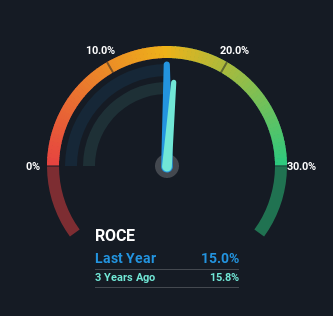- India
- /
- Auto Components
- /
- NSEI:BALKRISIND
There Are Reasons To Feel Uneasy About Balkrishna Industries' (NSE:BALKRISIND) Returns On Capital

What are the early trends we should look for to identify a stock that could multiply in value over the long term? Firstly, we'd want to identify a growing return on capital employed (ROCE) and then alongside that, an ever-increasing base of capital employed. This shows us that it's a compounding machine, able to continually reinvest its earnings back into the business and generate higher returns. In light of that, when we looked at Balkrishna Industries (NSE:BALKRISIND) and its ROCE trend, we weren't exactly thrilled.
What Is Return On Capital Employed (ROCE)?
If you haven't worked with ROCE before, it measures the 'return' (pre-tax profit) a company generates from capital employed in its business. The formula for this calculation on Balkrishna Industries is:
Return on Capital Employed = Earnings Before Interest and Tax (EBIT) ÷ (Total Assets - Current Liabilities)
0.15 = ₹13b ÷ (₹124b - ₹35b) (Based on the trailing twelve months to September 2022).
Thus, Balkrishna Industries has an ROCE of 15%. In absolute terms, that's a pretty normal return, and it's somewhat close to the Auto Components industry average of 13%.
Check out the opportunities and risks within the IN Auto Components industry.

Above you can see how the current ROCE for Balkrishna Industries compares to its prior returns on capital, but there's only so much you can tell from the past. If you're interested, you can view the analysts predictions in our free report on analyst forecasts for the company.
The Trend Of ROCE
In terms of Balkrishna Industries' historical ROCE movements, the trend isn't fantastic. Over the last five years, returns on capital have decreased to 15% from 19% five years ago. Although, given both revenue and the amount of assets employed in the business have increased, it could suggest the company is investing in growth, and the extra capital has led to a short-term reduction in ROCE. And if the increased capital generates additional returns, the business, and thus shareholders, will benefit in the long run.
In Conclusion...
Even though returns on capital have fallen in the short term, we find it promising that revenue and capital employed have both increased for Balkrishna Industries. And the stock has followed suit returning a meaningful 81% to shareholders over the last five years. So while the underlying trends could already be accounted for by investors, we still think this stock is worth looking into further.
One final note, you should learn about the 2 warning signs we've spotted with Balkrishna Industries (including 1 which is concerning) .
If you want to search for solid companies with great earnings, check out this free list of companies with good balance sheets and impressive returns on equity.
Valuation is complex, but we're here to simplify it.
Discover if Balkrishna Industries might be undervalued or overvalued with our detailed analysis, featuring fair value estimates, potential risks, dividends, insider trades, and its financial condition.
Access Free AnalysisHave feedback on this article? Concerned about the content? Get in touch with us directly. Alternatively, email editorial-team (at) simplywallst.com.
This article by Simply Wall St is general in nature. We provide commentary based on historical data and analyst forecasts only using an unbiased methodology and our articles are not intended to be financial advice. It does not constitute a recommendation to buy or sell any stock, and does not take account of your objectives, or your financial situation. We aim to bring you long-term focused analysis driven by fundamental data. Note that our analysis may not factor in the latest price-sensitive company announcements or qualitative material. Simply Wall St has no position in any stocks mentioned.
About NSEI:BALKRISIND
Balkrishna Industries
Manufactures and sells tires in India, Europe, North America, and internationally.
Solid track record with excellent balance sheet and pays a dividend.

